Workplace
To understand Workplace, it helps to think back on the discussion of Activities earlier in the book. A great thing about Microsoft CRM is that all interactions with our prospects, customers, contacts, and so on, are organized as Activities. This helps foster a working environment where we can ensure that nothing slips through the cracks or, to say it another way, where no balls get dropped. In this sense, Workplace can be thought of as the place to go to see all the balls that we have in the air. Whereas the home page showed us a quick glimpse of what was current or past due, the Workplace shows us all activities, including those that do not have due dates assigned.
The Workplace area is broken into four sub-areas: Workplace, Calendar, Activities, and Knowledge Base. The Workplace sub-area comes in two different versions: Sales and Service. Determining which version a user sees is configured through the user options screen. This screen can be reached by selecting Tools, Options from the main menu, as shown in Figure 6.17.
Figure 6.17. Selecting the user's version of Workplace.
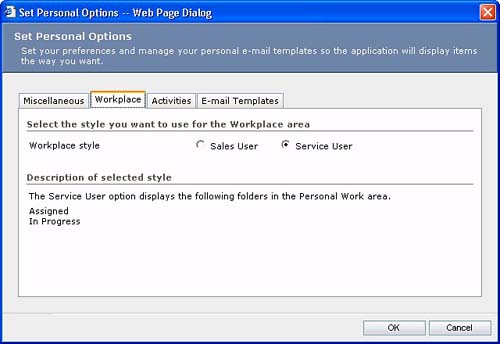
The Workplace Sub-area
The Workplace area consists of two separate sections: the user's Personal Work and Queues. In the Personal Work section, both the Sales and the Service versions of the Workplace sub-area have common folders named Assigned and In Progress. The Assigned folder shows the user all Cases and Activities that have been assigned to him by another user or by a workflow rule. It also shows all incoming emails that the Microsoft CRM Exchange connector has created as Email Activities. The user can check the Cases and Activities that he wants to accept and can then use the Actions list to accept these Activities. The accepted Cases/Activities will be moved to the In Progress folder. The In Progress folder lists all the user's Cases and Activities except those which have been assigned to the user, but not yet accepted. Both the Assigned and the In Progress folders display only Cases and Activities and not other records such as Leads, Contacts, Accounts, and Opportunities which have been assigned to the user.
Figure 6.18 shows the sales version of the workplace screen.
Figure 6.18. The Sales version of the Workplace screen.

The Sales version of the Personal Work section of the Workplace sub-area has two additional folders titled Email and Draft Email. The Email folder lists all incoming emails that are related to Microsoft CRM records. You might think of this as an email inbox exclusively for emails related to Microsoft CRM. As we've previously discussed, the Microsoft CRM Exchange connector takes incoming emails related to CRM objects, converts them to Email Activities and attaches them to those objects in CRM. These Activities are listed on the related objects' Activity History screen and are also displayed in the Workplace. Once in Workplace, the user can read, reply to, and forward these emails. When the user is finished working with the email, he may delete it from Workplace. Deleting the email from Workplace does not delete it from the CRM record(s) to which it is attached. Figure 6.19 shows the screen the user will see when deleting emails from Workplace.
Figure 6.19. The message a user sees when deleting emails from Workplace.
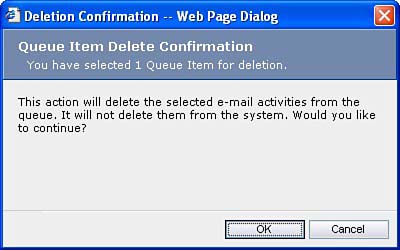
The Draft Email folder contains any Email Activities that have not yet been sent. After these emails are opened and sent, they disappear from this folder and appear in the Activity History tab of the record to which they are related.
Queues
The Queues section of the Workplace sub-area lists all the Queues across the organization. Because the Queue privilege set in Microsoft CRM security is either all or none (that is, Organizational/Global or none) users will see a list of all the Queues across the Organization regardless of their Business Unit. However, they will only see the Service cases over which they have view access.
The Calendar Sub-area
The Calendar sub-area shows a daily, weekly, or monthly view of the user's Appointment Activities. In addition, it enables the user to create a new Appointment by selecting the Appointment link to the right side of the screen, as shown in Figure 6.20.
Figure 6.20. The Monthly Calendar view.
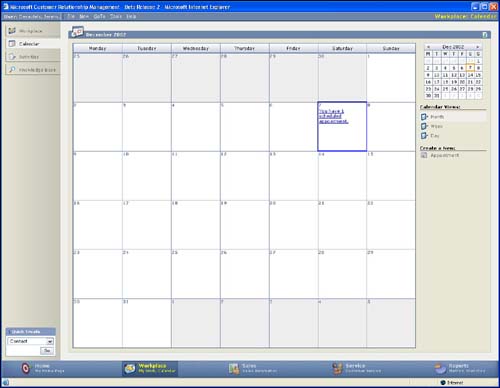
In version 1.0 of Microsoft CRM, a Web client user's calendar in Microsoft CRM is not synchronized with the user's calendar in Outlook. However, user's of the Microsoft CRM Sales for Outlook client will be able to create calendar appointments that appear in their Outlook calendar, their Microsoft CRM calendar, or both.
The user has control over two Calendar items through user Options. The Options screen can be accessed my selecting Tools, Options on the menu bar and then selecting the Activities tab, as shown in Figure 6.21.
Figure 6.21. Changing the user's Calendar options.
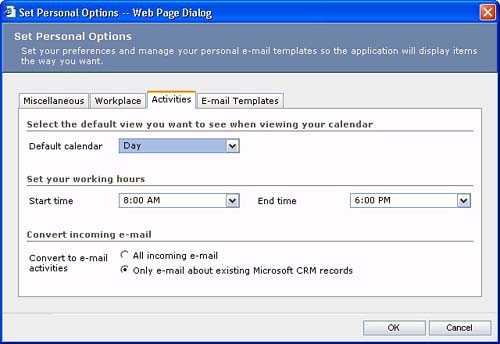
On the Activities Options screen, the user can set which Calendar view they would like to see by default. These include Day, Week, or Month. Also, the user can select their typical working hours. This setting affects which hours are presented in a lighter grey color on the user's daily Calendar view.
The Activities Sub-area
The Activities screen shows all of the user's open Activities regardless of whether the Activities have just been assigned or are in progress. This is the catch all view for Activities, as shown in Figure 6.22.
Figure 6.22. The Activities screen in Workplace.
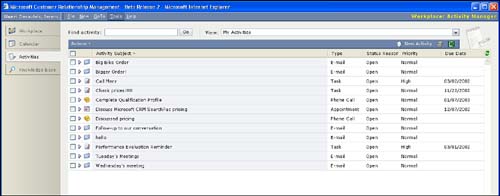
One downside of this view is that, in Version 1.0, you cannot customize the column set and, as such, are stuck with the Activity Subject column as your main way to identify the Activity without opening it. For most users, this makes it difficult to discern one Activity from another; especially when you have automated workflow rules creating Activities with the same subject descriptions. This view does, however, enable the user to sort Activities by type and due date, which is helpful.
The Knowledge Base Sub-area
The final sub-area of the Workplace Area is Knowledge Base. The Microsoft CRM Knowledge Base component enables users to create multiple Knowledge Base (KB) article templates, which can then be used to create KB Articles. After a KB Article is created, it is submitted for approval. When the Article is approved, it is considered to be in published status and can be searched or browsed through the Knowledge Base sub-area of Workplace, as shown in Figure 6.23.
Figure 6.23. The Knowledge Base sub-area of Workplace.

Because each KB article must be associated with a Subject, you can use the Browse tab of the KB sub-area to browse lists of all KB Articles associated with a particular Subject. One thing to keep in mind when doing this is that when you select a Subject that has child Subjects attached to it, you will not see articles associated with the child Subjects unless you choose those child Subjects specifically. We'll cover Knowledge Base in more detail in Chapter 8.
